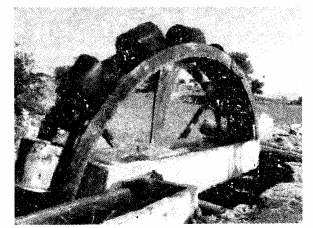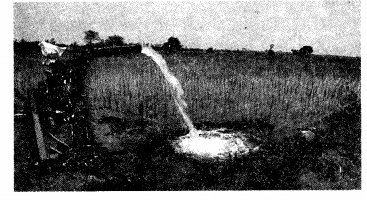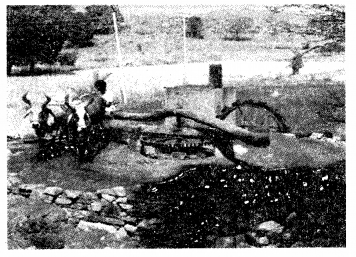RBSE Solutions for Class 5 Environmental Studies Chapter 10 Flow of Water is part of RBSE Solutions for Class 5 Environmental Studies. Here we have given Rajasthan Board RBSE Class 5 Environmental Studies Chapter 10 Flow of Water.
| Board | RBSE |
| Textbook | SIERT, Rajasthan |
| Class | Class 5 |
| Subject | Environmental Studies |
| Chapter | Chapter 10 |
| Chapter Name | Flow of Water |
| Number of Questions | 45 |
| Category | RBSE Solutions |
Rajasthan Board RBSE Class 5 Environmental Studies Chapter 10 Flow of Water
Text Rook Questions
Think and answer the following (Page No. 57)
Question 1.
Where have you seen the flowing water?
Answer:
We have seen the flowing water in canals, springs, drains, rivers etc.
Question 2.
At which places in your nearby area have you seen the flowing water being used?
Answer:
Flowing water is being used in generating hydro-electricitv and provide facilities of irrigation.
Think and write the answers of the following questions (Page No. 57)
Question 1.
From where is the water available for agriculture?
Answer:
The water for agriculture is available from canals, rivers, ponds, water of rainfall etc.
Question 2.
If water does not reach equally everywhere in the fields, what will be the effect on the crops?
Answer:
Excessive rainfall destroys crops and the scarcity of rainfall creates drought.
Question 3.
What efforts should we make so that the entire field may get sufficient amount of water?
Answer:
For this we can supply water by fountain process.
Explore and write the answers of the following questions (Page No. 58)
Question 1.
Look at the above figures (Page No. 58) and write how is the water reaching the farms.
Answer:
Irrigation in the field through a tube well with pipelines and motor.
Question 2.
In which methods of irrigation, the animal labour has been in use?
Answer:
In RAHAT irrigation, the animal labour has been used.
Question 3.
In which methods of irrigation, electricity is being used?
Answer:
In motor and pumpset irrigation, electricity is being used.
Question 4.
In the above given figures (Page No. 58), in what way is the property of water to flow from upwards to downward direction is being used?
Answer:
The water which comes through the tube wells, flows to the crops in the field.
Question 5.
Which methods of irrigation have been in use in your nearby fields?
Answer:
In our nearby fields the irrigation facilities of fountain, motor, rahat, pipelines etc. are used.
Question 6.
Look at the figures given above and tell in which methods the water is being extracted from ground?
Answer:
The water is being extracted from the ground by pipelines or motor.
Question 7.
Which equipment have been used to extract water from the ground?
Answer:
Motors and hand pumps have been used to extract water from the grounds.
Explore (Page No. 59)
Question 1.
For which crops the farms are required to remain completely filled with water?
Answer:
For sugarcane and paddy, farms are required to remain completely filled with water.
Question 2.
Which crops can be grown even with a very less amount of water?
Answer:
Peas, gram, onion, cucumber require ess amount of water.
Learnt, understood and now tell (Page No. 60)
Question 1.
The water flows from upward to downward direction. How can you use this property of water in different ways?
Answer:
The water flows from upward to downward direction. This water is used for drinking purpose, generating hydro-electricity and increasing the facility of irrigation.
Question 2.
In what ways we take out water from the well?
Answer:
With the help of ropes and buckets, the water is taken out from the wells. Nowadays,rahat and motor pumps are also used for taking out the water from the wells.
Question 3.
If the water level goes down, how can the water be taken out by rahat?
Answer:
If the water level in the well goes down, the level of water should be made equal to the rahat level. After that the water can be taken out by rahat. Else it is not possible.
Question 4.
Which are the different methods of irrigation?
Answer:
The different methods of irrigation are—tubewells. motor set. pump set. rahat, fountains, wells, canals, bawadis etc.
Other Important Questions
Objective Type Questions :
Question 1.
Method of irrigation
(a) Motor
(b) Rahat
(c) Fountain
(d) All of the above
Answer:
(d) All of the above
Question 2.
Which crop requires less amount of water?
(a) Sugarcane
(b) Onion
(c) Paddy
(d) Rice
Answer:
(b) Onion
Question 3.
Which crop requires more rainfall?
(a) Sugarcane
(b) Gram
(c) Cucumber
(d) Onion
Answer:
(a) Sugarcane
Question 4.
The water of rahat falls on this place of the
(a) In the hole
(b) In w’ell
(c) In parapet
(d) In drain
Answer:
(c) In parapet
Fill in the blanks :
1 ………..are used to operate the rahat. (oxen / camel)
2. Water always ………….from upwards to downwards. (flows / climbs)
3. A wheel like structure installed over the shallow’ well is called ……….. (rahat / fountain)
4 The water of rahat flows to ……….. and reaches the farms. (pipe / drains)
Answer:
1. (oxen).
2. (drains).
3. (rahat).
4. (drains).
State True or False
Question 1.
Irrigation is necessary for crop production.
Answer:
true
Question 2.
Water always flows from downwards to upwards.
Answer:
false
Question 3.
Motor is regulated by electricity.
Answer:
true
Question 4.
Ground water level is the main source of water of the well.
Answer:
true
Very Short Answer Type Questions :
Question 1.
In which direction does the water flow )
Answer:
The water flows from upward to downward direction.
Question 2.
Do all crops require equal quantity of w;ater?
Answer:
No, the requirement of water for every crop is different.
Question 3.
Name 4 crops which require less amount of water.
Answer:
(i) Peas
(ii) Gram
(iii) Onion
(iv) Cucumber
Question 4.
Name 2 crops which require more water.
Answer:
Sugarcane and paddy.
Question 5.
Where is rahat found?
Answer:
Rahat is installed over the shallow wells or step wells.
Question 6.
Winch animals are used to operate the rahat?
Answer:
Oxen
Question 7.
Due to which equipment, the use of oxen is reduced?
Answer:
The electric motors.
Short Answer Type Questions :
Question 1.
What is irrigation?
Answer:
If there is no rain or it is scanty, then the w’ater has to be given separately to the crops depending upon the requirement. This process is known as irrigation.
Question 2.
Describe the requirement of less and more water for different crops.
Answer:
The requirement of water for every crop is different. Some crops need more water and some need a lesser amount. In this way, wastage of w’ater can be prevented. The crops of rice, sugarcane and paddy require more water, whereas the crops of peas, gram, onion, cucumber require less amount of w ater. If a farmer has a good knowledge about it. then water can be used properly.
Question 3.
Look at the given picture of a Rahat and frame any 3 questions to seek more information about it. (Model Paper)

Answer:
(i) What is Rabat and where is it attached?
(ii) What is used to run it?
(iii) In what work is the Rahat used
Question 4.
Look at the given picture of the tubewell and frame any 3 questions to seek more information about it.

Answer:
(i) How is the water from the tubewell removed?
(ii) How to use tubewells for irrigation?
(hi) From where the water is removed from the tubewell?
Question 5.
Look at the picture and explain the irrigational process by Rahat.

Answer:
(i) A Rahat is a wheel-like structure installed over the shallow wells or stepwells.
(ii) Many vessels of w ater are attached over it Wlien they enter the water inside the well, the vessels get filled with water.
(iii) Oxen are used to operate the Rahat.
(iv) When the vessels come out from the well, they move from upwards to downwards directions, the wheel rotates and the water continuously falls on the parapet of the w ell.
(v) From here, the w’ater flows through the drains and reaches the farms and helps in irrigation.
Essay Type Question :
Question 1.
How does a rahat work?
Answer:
A rahat is a wheel like structure installed over shallow wells or stepwells. Many vessels of water are attached over here. When the vessels come out from the well, they move from upward to downward direction and the water continuously falls on the parapet of the well. The water of rahat flows to the drains and reaches the farms.Oxen are used to operate the rahat. Nowadays, the electric motors are more frequently used due to which the use of oxen is reduced.
We hope the RBSE Solutions for Class 5 Environmental Studies Chapter 10 Flow of Water will help you. If you have any query regarding Rajasthan Board RBSE Class 5 Environmental Studies Chapter 10 Flow of Water, drop a comment below and we will get back to you at the earliest.